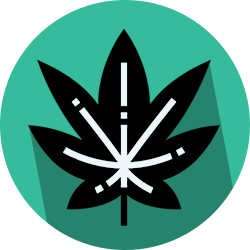Sentinel Surveillance of Substance-Related Poisonings in Canada: Spotlight on Cannabis Published: ()
Key findings
- Of all poisoning cases caused by various chemicals and/or substances in the electronic Canadian Hospitals Injury Reporting and Prevention Program (eCHIRPP) database, 41.8% of poisoning cases involved at least one of the following six substances: alcohol, cannabis, methamphetamine, opioids, cocaine, and e-cigarette/vaping products.
- Alcohol was the most commonly reported substance (69.1%), followed by cannabis (20.4%).
- Where the use of more than one type of substance was reported (polysubstance use), the most frequent combination was alcohol with cannabis (35.9%).
- The rate of substance-related poisonings was higher in adults aged 20 years and older, compared to children and youth 19 years and under (3,204.4 cases per 100,000 eCHIRPP records vs 777.0 cases per 100,000 eCHIRPP records, respectively).
- The percentage of hospital admissions for cannabis-related poisonings was similar to the percentage of admissions for all six select substance-related poisoning cases (8.6% vs 8.7%, respectively).
- Intentional self-harm with or without suicidal intent was reported among 20.2% of all select substance-related poisoning cases, compared to 15.9% of cannabis-related poisoning cases (including polysubstance use).
Substance-related poisonings and injuries in Canada have received increasing attention in recent years due to emerging public health concerns, such as the opioid overdose crisis, the introduction of synthetic cannabinoids to the illicit market and the emergence of electronic cigarettes/vaping products on the Canadian market. Furthermore, there has been a general increase in substance-related hospitalizations and deaths during the COVID-19 pandemic compared to the same period in 2019 Footnote 1, Footnote 2.

This data blog presents statistics on poisonings from six select substances, namely alcohol, cannabis, methamphetamine, opioids, cocaine and e-cigarette/vaping products. It is the fourth data blog in a series presenting statistics on substance-related poisonings reported by the Canadian Hospitals Injury Reporting and Prevention Program (CHIRPP), and features a spotlight on cannabis. The first data blog presented key findings from surveillance studies based on analyses of the electronic CHIRPP database (eCHIRPP). The second data blog presented statistics on poisonings from opioids; the third data blog presented statistics on poisonings from methamphetamine.
The surveillance of injuries and poisonings by CHIRPP and other initiatives have continued throughout the COVID-19 pandemic, and future surveillance studies will consider its impacts on the burden of substance-related poisonings and other contexts. This work helps to shed light on substance-related harms in Canada, and complements information from other data sources.
Cannabis use and the Canadian context

Cannabis use has become increasingly prevalent in Canada Footnote 3. Between 2004 and 2017, past-year cannabis use among Canadians aged 15 years or older has significantly increased from 9.4% to 14.8% Footnote 4. In October 2018, Canada legalized the non-medical use of cannabis for adults, following the legalization of cannabis for medical purposes nearly two decades earlier Footnote 5. Furthermore, a wider variety of cannabis products, including cannabis edibles, topicals, and extracts were legalized for production and sale in Canada in October 2019 Footnote 6.
Recent work using data from the National Cannabis Survey (NCS) investigated changes in cannabis use pre- and post-legalization and found that the prevalence of past-three-month cannabis use significantly increased from 14% in 2018, to 20% in 2020 Footnote 7. New evidence also suggests that the COVID-19 pandemic may have influenced cannabis use among Canadians. Data collected through the Canadian Perspectives Survey Series suggest that among respondents aged 15 to 29 years who had previously consumed cannabis, 43% reported increasing their cannabis consumption during the pandemic Footnote 8. However, when considering cannabis use across all age groups, early findings from the Canadian Cannabis Survey 2020 suggest that the majority of individuals who used cannabis in the past 12 months reported using the same amount of cannabis during the COVID-19 pandemic Footnote 9. Cannabis-related emergency department visits and hospitalizations have also increased during the pandemic Footnote 1.
Adverse health outcomes associated with cannabis use include fatal and non-fatal injuries sustained during motor vehicle collisions involving cannabis-related impairment Footnote 10, Footnote 11, Footnote 12, Footnote 13, acute ingestions among children causing poisonings, decreased levels of consciousness and other symptoms Footnote 14, Footnote 15, Footnote 16, Footnote 17, Footnote 18, and intoxication, gastrointestinal ailments, and psychiatric and other symptoms among adults Footnote 19.
What we know about substance-related poisonings from eCHIRPP
How cases were identified
A search in the eCHIRPP database was conducted to select all cases that were recorded with an injury date of April 1, 2011 up to and including May 11, 2021 where the first (most severe) diagnosis was a poisoning (n = 46,454, representing 3.1% of eCHIRPP records).
Among all poisonings, which encompass various chemicals and/or substances, those related to alcohol, cannabis, methamphetamine, opioids (including codeine, oxycodone, morphine, heroin, fentanyl, and others), cocaine, and e-cigarette/vaping products were then identified using bilingual search terms.

How many substance-related poisoning cases were there, and what was the distribution of the substances used?
Overall, 41.8% of poisoning cases (19,416 out of 46,454 poisoning cases) involved at least one of the following six substances: alcohol, cannabis, methamphetamine, opioids, cocaine, and e-cigarette/vaping products. These substance-related poisonings represent 1.3% of all eCHIRPP records during the study period.
Among all select substance-related poisonings, alcohol was the most commonly reported substance (69%), followed by cannabis (20%). The ranking of all six select substances and the percentages in relation to all substance-related poisoning cases (n = 19, 416) are as follows:
- Alcohol (n = 13,409, 69.1% of cases)
- Cannabis (n = 3,961, 20.4% of cases)
- Opioid (n = 2,732, 14.1% of cases)
- Methamphetamine (n = 2,306, 11.9% of cases)
- Cocaine (n = 1,385, 7.1% of cases)
- E-cigarette/vaping productsFootnote † (n = 163, 0.8% of cases)
Note that these percentages do not add to 100% because many patients reported using more than one type of substance at a time (polysubstance use).

Sex and age
Sex and age statistics are presented as proportions relative to the total number of all records in the eCHIRPP database.
Among all select substance-related poisonings (including those involving cannabis), females represented 1,355.1 cases per 100,000 eCHIRPP records, compared to males at 1,247.8 cases.
Among cannabis-related poisonings (including polysubstance use), females represented 270.9 cases per 100,000 eCHIRPP records, compared to males at 259.0 cases.

In terms of age groups, among all select substance-related poisonings (including those involving cannabis), adults aged 20 years and older represented 3,204.4 cases per 100,000 eCHIRPP records, compared to children, youth and young adults aged 0 to 19 years at 777.0 cases. The number of cases along with their respective normalized counts for each age group are presented in Table 1.
| Age group | Number of cases | Cases/100,000 eCHIRPP records |
|---|---|---|
| 0 to 19 years | 9,187 | 777.0 |
| 0 to 4 years | 706 | 178.1 |
| 5 to 9 years | 130 | 46.8 |
| 10 to 14 years | 2,205 | 665.8 |
| 15 to 19 years | 6,146 | 3,467.9 |
| 20+ years | 10,217 | 3,204.4 |
| 20 to 29 years | 2,784 | 3,493.4 |
| 30 to 39 years | 2,584 | 4,682.2 |
| 40 to 49 years | 1,928 | 4,240.6 |
| 50 to 64 years | 2,233 | 3,225.1 |
| 65+ years | 688 | 993.4 |
| Total*** | 19,404 | 1,292.5 |
Regarding cannabis-related poisonings among children and adults, adults aged 20 years and older represented 319.6 cases per 100,000 eCHIRPP records, compared to children, youth and young adults aged 0 to 19 years at 248.7 cases. The number of cases along with their respective normalized counts for each age group are presented in Table 2.
| Age group | Number of cases | Cases/100,000 eCHIRPP records |
|---|---|---|
| 0 to 19 years | 2,941 | 248.7 |
| 0 to 9 years | 291 | 43.2 |
| 10 to 14 years | 698 | 210.8 |
| 15 to 19 years | 1,952 | 1,101.4 |
| 20+ years | 1,019 | 319.6 |
| 20 to 29 years | 469 | 588.5 |
| 30 to 39 years | 261 | 472.9 |
| 40 to 49 years | 137 | 301.3 |
| 50 to 64 years | 130 | 187.8 |
| 65+ years | 22 | 31.8 |
| Total*** | 3,960 | 263.8 |
When considering age and sex together, among all select substance-related poisonings (including those involving cannabis) males aged 30 to 39 years represented 4,860.9 cases per 100,000 eCHIRPP records, followed by males aged 40 to 49 years at 4,760.0 cases and females aged 15 to 19 years at 4,550.3 cases per 100,000 eCHIRPP records.
Among cannabis-related poisonings (including polysubstance use), females aged 15 to 19 years represented 1,211.6 cases per 100,000 eCHIRPP records, followed by males aged 15 to 19 years at 1,019.0 cases, and males aged 20 to 29 years at 660.1 cases per 100,000 eCHIRPP records.

What percentage of cases were admitted to hospitals?
The percentage of hospital admissions for cannabis-related poisonings was similar to the percentage admitted for all select substance-related poisoning cases (8.6% vs 8.7%, respectively).

Where did the substance-related poisonings happen?
Location information was unknown in 45.4% of all substance-related poisoning cases. Among cases where location was known (n = 10,598), the majority of substance-related poisonings occurred in a residential setting at 61.2% (n = 6,488), such as at the person’s home or a friend’s house.
Location information was unknown in 44.9% of cannabis-related cases. Among cases with an identified location (n = 2,182), the majority of cannabis-related poisonings occurred in a residential setting at 62.3% (n = 1,359), such as at the person’s home or a friend’s house.

How common was using more than one substance at a time?
The use of more than one type of substance at a time (polysubstance use) was reported in 20.0% (n = 3,874) of all select substance-related poisonings cases. The following top three polysubstance use combinations each involved two substances:
- Alcohol with cannabis, in 35.9% (n = 1,392) of polysubstance use cases (and in 7.2% of all substance-related poisonings).
- Alcohol with methamphetamine, in 12.1% (n = 468) of polysubstance use cases (and in 2.4% of all substance-related poisonings).
- Alcohol with cocaine, in 11.9% (n = 460) of polysubstance use cases (and in 2.4% of all substance-related poisonings).

What proportion of cases were intentional self-harm?
Intentional self-harm (with or without suicidal intention) was reported among 20.2% of all substance-related poisoning cases (including those involving cannabis), compared to 15.9% of cannabis-related poisoning cases (including polysubstance use).

What was the intent of using only cannabis, vs. cannabis combined with other substances?
Among cannabis-related events, intent was determined in 82.6% (n = 3,270) of cases (e.g., unintentional, intentional self-harm with or without suicidal intention, assault, or other intent such as medical or surgical complications and police operation). The remaining cases were coded as “Event of undetermined intent”.
When considering intent of cannabis use without other substances vs. cannabis in combination with other substances, the two most common circumstances reported for both groups were:
Cannabis without other substances (n = 1,648):
- Unintentional poisoning at 82.9% of all single cannabis use cases (n = 1,366)
- Intentional self-harm with or without suicidal intent at 15.4% of all single cannabis use cases (n = 253)
Cannabis in combination with other substances (n = 1,622):
- Unintentional poisoning at 73.7% of all polysubstance cannabis cases (n = 1,196)
- Intentional self-harm with or without suicidal intent at 23.1% of all polysubstance cannabis cases (n = 375)
More about the data source
CHIRPP is an injury and poisoning sentinel surveillance system currently operating in the emergency departments of 11 paediatric and ten general hospitals across Canada Footnote 20, Footnote 21. It collects patients’ accounts of pre-event injury circumstances (“What happened?”), and clinical information is added to the data collection form by hospital staff Footnote 20, Footnote 21. CHIRPP captures a more complete picture of the injury event than hospital administrative or mortality data alone, and also identifies less serious injury cases that do not require hospitalization Footnote 21.
This study does not represent all substance-related poisonings in Canada, as CHIRPP operates at select Canadian hospitals and only select substances where a poisoning was the most severe diagnosis were considered. Adults older than 18 years of age, Indigenous peoples including Inuit, Metis and First Nations, and people who live in rural areas may be under-represented in the eCHIRPP database, as most CHIRPP sites are paediatric hospitals located in major cities. Intentional self-harm may also be underreported among patients wishing not to disclose the intent of their poisonings. Fatal injuries are also under-represented in the eCHIRPP database because the emergency department data do not capture people who died before they could be taken to hospital or those who died after being admitted via another department. Information is continuously being entered into the eCHIRPP database; therefore, some years do not yet have complete data.